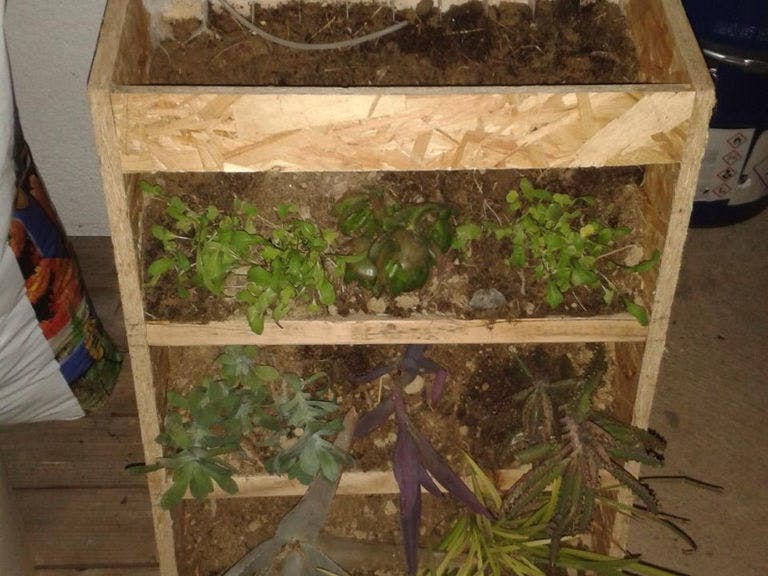BioEdison is a smart vertical garden based on the new Intel Edison that allows a simple, automated management of any type of vegetable or plant.
Advantages of BioEdison control device than a traditional vegetable garden are the efficient use of space and resources and the ability to communicate to the user the status of the plants and the possible need for human intervention (such as supply of water tank).
The project is based almost entirely on the components contained in the Groove Kit for Intel Edison.
Step 1: Everything you NeedElectronics:
- Intel® Edison and Arduino Breakout kit
- Grove starter kit plus – Intel IoT Edition for Intel Galileo Gen 2 and Edison
- Light sensor
- Base Shield
- Buzzer
- Red Led
- Green Led
- Blue Led
- Moisture Sensor (x2)
- Button
- Ultrasonic sensor (Arduino Compatible)
- MOSFET IRLZ44N (x2)
- Diodes 1N4007 (x2)
- Electrical junction box for outdoor use L.120 x P 500 x H80 mm
- Matrix board
- 78L05 Voltage regulator
- Electrolytic or tantalum Capacitor 100mF 16V (x2)
- Polyester Capacitor 100 nF (x2)
- Pair DC Power Socket & Plug Solder terminal 12V (Male and Female)
- 5 terminal connectors (optional)
Mechanics and hydraulics
- Pump irrigation @12V DC
- Pipes (of diameter corresponding to that of the pumps), 2 meters in length
- 25 or 30 liter canister
Structure
- Screws
- Boards OSB
- Silicone
- Glue
- Wooden board 40x10mm x 2
- stones
Software
- Installer Intel® Edison
First thing you need to mount the breakout board in Edison on 'appropriate accommodation'. After doing this you have to make the first start of Edison and the basic configurations.
Here you can find several links with the guides for installing Intel XDK, the first set up of Edison and the first Hello World.
Intel® Edison Board Getting Started Guide: https://software.intel.com/en-us/iot/library/edison-getting-started
Intel® XDK IoT Edition Getting Started Guide: https://software.intel.com/en-us/intel-xdk-iot-edition-guide
Arduino IDE for Intel Edison support: https://www.arduino.cc/en/Guide/IntelEdison
Download the source code from Github: https://github.com/VeronaFabLabRepo/intel_maker_orto
Step 3: Driving Circuit of the PumpsFor the project it is essential that irrigation pumps can be driven through the Edison, and then to be able to drive the motors (powered at 12 volts) with a signal of Edison (5 volts) is necessary to resort to the use of a MOSFET transistor or a relay.
Both work as switches enabling the switching on or off of the pumps and then irrigation. For this project we used two MOSFETs instead of the relays because of their small size and low power consumption.
The part of the circuit that supplies 5 volts has been added for future developments in a possible next version.
Step 4: Mounting FrameThe structure of the garden is built with boards of OSB and is designed in modules that can be stacked or side by side.
Below are the designs for the cutting of the pieces (all measurements are in cm) and the sequence of photos for the construction of the module that will contain garden plants.
- Cut the 4 boards of OSB (40x60cm)
- Place 2 of the 4 tables
- Mount one of the two tables together to a base of size (40x24cm)
- Place the bottom of the container (40x60cm) following the inclination of the cutting plane (thanks to inventories of the cut made in step 1)
- Install the second panel cut in 1) closing the container
- Fit the two support bases (40x6)
- Done! Now enter the second intermediate shafts as supports and dividers. In our case the entire box is divided into 3 parts (but we can opt for 2 or 4 dividers). A once seated and secure such media can add the spacer on the back to the soil, the rocks at the base to drain water and possibly crop plants mixed with other soil.
Before connecting the out pipe (that arrive from pump) drill holes (as reported in pictures) some parts in correspondence of areas where plants are placed and water come out.
Step 5: Let's see the ResultsFrom this page it is possible to view all data collected and stored in the "cloud" http://104.40.139.35/bioedison/
Step 6: ConclusionThe current version of this project provides a fully automatic control for basic management of a home vegetable garden or houseplants going to use the minimum of resources (number of sensors, capacity liters of water, irrigation meters, etc. ).
The project was however conceived and designed to evolve with a possible version 2.0 offers the ability to add or change current sensors and thus be adapted to different application needs that this type of use requires.














_3u05Tpwasz.png?auto=compress%2Cformat&w=40&h=40&fit=fillmax&bg=fff&dpr=2)
Comments